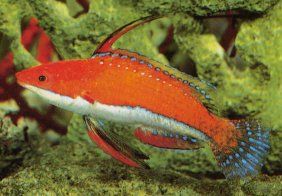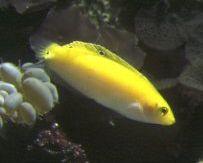 Family: Labridae
Family: Labridae
If I was asked to name one group of fish which featured a wealth of attributes such as beautiful coloration, tireless activity from dawn to dusk, ease of feeding, a generally peaceful nature, compatibility with invertebrates and disease resistance, I would lay odds that the questioner would not be expecting a realistic reply.
And it might be true to admit to some difficulty in identifying an individual fish that would fit the bill, let alone a group! But they do exist and they are called - Dwarf Wrasses! This might be a fresh term to many marinists, but by that I mean wrasse that grow no larger than 10cm (4").
Without a doubt, the family Labridae is a very large one, encompassing well over 400 species. Sizes occupy a vast range with the smallest never exceeding a miniature 6cm (2.5") and the largest proving a monster at 2.1m (7ft) ! Only a fraction of these are available to the hobbyist as viable tank specimens but nonetheless the choice is still quite broad and very appealing.
It is not widely known that many juvenile wrasse act as cleaner fish - discounting the Common Cleaner Wrasse (Labroides dimidiatus) which spends its whole life performing such duties - and these are generally recognised by their distinctive red and white livery, although such coloration is not exclusive to cleaning wrasse. One theory for this type of behaviour argues that it gives the very young fish an opportunity to mix safely with other larger, and potentially predatory species, in relative safety; and this would seem a very reasonable explanation. Whatever the reason, it certainly their masquerade works very well as juvenile wrasse are very common on the reef. 

Feeding
Owing to the immense numbers involved within the wrasse family, it is just not possible to make too many generalisations regarding various characteristics but it would be fair to say that nearly all species are opportunistic feeders. They will scavenge the rocks and bottom for marine worms, crustacea and almost anything edible, whilst also keeping an eye open for any suitable planktonic foods that might be drifting in the current. Even though wrasse are very catholic in their tastes, algae does not appear to feature as a favourite diet for any particular species.
Nighttime Protection
Nearly all wrasse, and particularly the dwarf species, take refuge during the hours of darkness below a soft, sandy substrate, sometimes burying themselves up to 3" beneath the surface. This strategy for nightime security should, as far as possible, be provided for in the aquarium by supplying a few inches of coral sand on the base of the aquarium. If there is none available, the fish do not appear to be unduly stressed as long as there is plenty of rockwork within which to hide.
A Beginner's Fish?
Most species prove excellent choices for enthusiasts at all stages of the hobby. Easy going temperaments make them good community fish and very desirable for the mixed fish/invertebrate aquarium.

Feeding in the Aquarium
Practically any marine fare will suit dwarf wrasses. They are greedy feeders and will accept flake, brineshrimp, mysis, lobster eggs; in fact, almost anything that can be swallowed!
Mixing it Up
In most cases dwarf wrasses cannot be mixed in the aquarium. Two wrasse of the same species will usually fight until one, or both, are dead. Even unlike species cannot be trusted and usually end up in a vicious scrap. Admittedly, one might see a tank full of same-species wrasse in a dealers tank appearing to offer no problems, but this will generally not carry over to the showtank where territories are soon established and defended vigorously.
Diseases
In most cases, dwarf wrasse are very resistant to all manner of diseases. Wrasse rarely contract any serious ailments where water conditions are good and are consequently capable of surviving for many years. An exception worth mentioning is the Cleaner Wrasse, as this is highly susceptible to illness where water conditions are in a state of deterioration.
Tank Size and Water Conditions
Dwarf Wrasse are ideal for aquaria as small as 36"x15"x12", although larger tanks are always preferable. Ammonia and nitrite: zero, nitrates; not exceeding 25ppm but much lower if possible, Specific Gravity: 1.020-1.024, Temperature: 75-79øF, Good quality water changes of 15-20% every fortnight. Activated carbon filtration and efficient protein skimming as standard.
Lighting 

Wrasse in themselves are not at all fussy about lighting conditions and will thrive in moderate to bright conditions, depending on the requirements of other livestock sharing the same tank.
Healthy Stock
Dwarf wrasse are always active and must be seen to so. They should have clear eyes, and unblemished bodies. Fins should show no signs of being ragged or clamped to the body. A healthy appetite is also a sure sign of good health. Freshly imported specimens may have a tendency to hide beneath the sand for a day or so, but no longer if they are in good health. A move to a new aquarium might also elicit the same response. Under no circumstances must any attempt be made to 'dig it out' unless it remains unseen for more than 3-4 days. In cases such as this, disease is usually the cause and must be treated immediately.
 Detecting Dwarf Species
Detecting Dwarf SpeciesThe question is often asked, "how can I tell a Dwarf Wrasse from a larger species?" And the answer is, you can't, unless you do some homework on the subject first! For example, many species of wrasse are imported as tiny juveniles in a more attractive and saleable colour form. These include the African Clown Wrasse and the Twin-Spot Wrasse. Both can be found on sale at around 2.5cm (1") in length, however, within a few short years they will each achieve 20-30cm (8-12")!
Some Desirable Species
The Cleaner Wrasse (Labroides dimidiatus)
The Dwarf Parrot Wrasse (Cirrhilabrus rubriventralis)
The Banana Wrasse (Haliochoeres chrysus)
The Banana Wrasse (Haliochoeres trispilus)
The Pyjama Wrasse (Pseudocheilinus hexataenia)
The Dragon Wrasse (Novaculichthys taeniorus)
Parrot Wrasses (Cirrhilabrus sp.)
Green Wrasse (Haliochoeres chloropterus)
Fourline Wrasse (Larabicus quadrilineatus)
Various Coloured Cleaner Wrasse (Labroides sp.)
The Dwarf Parrot Wrasse (Cirrhilabrus rubriventralis)
The Banana Wrasse (Haliochoeres chrysus)
The Banana Wrasse (Haliochoeres trispilus)
The Pyjama Wrasse (Pseudocheilinus hexataenia)
The Dragon Wrasse (Novaculichthys taeniorus)
Parrot Wrasses (Cirrhilabrus sp.)
Green Wrasse (Haliochoeres chloropterus)
Fourline Wrasse (Larabicus quadrilineatus)
Various Coloured Cleaner Wrasse (Labroides sp.)
© Nick Dakin. May not reproduced in part, or whole, without permission.

